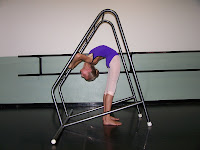A New First-Person Post from StretchGym Model Emma
I began dancing at the age of four. Since then, I've been training at a pre-professional ballet school. When I was young, I did not have natural flexibility. As a ballet dancer, flexibility is very important so I began stretching. I took a stretch class every week, but the class wasn't enough help. I wanted to not only focus on increasing my flexibility, but also to develop the core strength necessary to hold these positions. The design of the StretchGym allowed me to reach my highest potential in flexibility. One of my favorite aspects about the StretchGym is that it provides resistive stretching.
I struggled particularly with my straddle stretch and frog
stretch (see left). I was about four inches off the floor from being flat. Resistive stretching helped me to warm up my muscles more effectively. After about five months of consistent stretching I could lay flat comfortably in my straddle.


Although
I had my right and left splits, I used the StretchGym for my over-splits. I started off on the lowest bar, and as the
position became more comfortable, I would try the next higher bar to increase
resistance. My over-splits have been my biggest area of improvement. The photo below was taken in 2010, after 2 months of training on the StretchGym.

Today I am able to reach between the 4th and 5th bars on the StretchGym, which is about a 225 degree over-split.
This has also improved my developes that I can now hold at 180 degrees.
Here are my vertical over-splits from 2010 (on left) to 2013 (on right).
Through
these stretches I have also worked on my penches. Every week after my muscles were warm from
stretching, my stretch trainer would record my static and active penches. My static (held) Penche and dynamic (kicking) penche are shown on below on the right.

 Left, 2011; Right, 2013
Left, 2011; Right, 2013
By adjusting my torso a bit to the side, and leaning back more, my trainer showed me that I could perform over-split side and front kicks. The collage is from 2011.
Side and front kicks from 2013 below.
I have been also working on my back stretches which include twisting, front bends, back-bends back leg over-splits and arabesques. As a dancer there is always room for growth and improvement, and the StretchGym has helped my flexibility beyond what I had ever imagined!


.JPG)

.png)











































